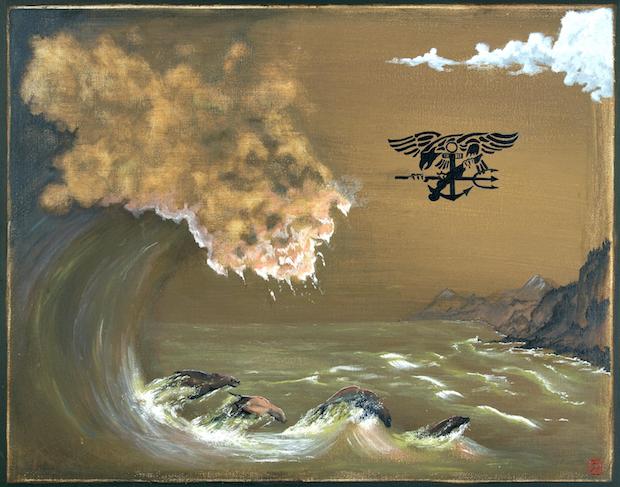The Mysteries That Drive Our Creative Forces
by Bill O'Brien

Seal Fireteam An interpretation of a fireteam of U.S. Navy SEALs escaping a storm by Rusty Noesner. Photo courtesy of the artist.
Who is an artist? What motivates them to pursue art?
I have been pondering these two questions since I participated in a working group that the NEA co-organized with the Santa Fe Institute a little over two years ago, “How Creativity Works in the Brain.” Recently, I attended a conference at the National Harbor in Oxon Hill, Maryland, where two compelling answers to these questions emerged from unexpected sources.
The conference, Show of Strength-A Day of Healing Arts: From Clinical to Community, took place on November 16th and was co-hosted by the Department of Defense Office of Warrior Care Policy, the Air Force Wounded Warrior Program, and the National Endowment for the Arts. The focus of the convening was the role the arts can play to advance healing for military and veteran populations in both clinical and community settings.
It featured standup comedy, spoken word, theater, and music performed by combat veterans from the various branches of the military. It also included an exhibit of more than a dozen artists who have incorporated painting, photography, and blacksmithing into their healing processes. Among those who spoke about the impacts of the arts were two graduates of Creative Forces: NEA Military Healing Arts Network's clinical programs: Michael “Rod” Rodriquez and Rusty Noesner.
Rod shared that, throughout his service, he felt fortunate that “the 12 times I was blown up I kept all my pieces so I could internalize and hide my injuries.” This allowed him to self-treat and “stay in the fight.” When people later asked why he didn’t seek help earlier, he compared his situation to children who won’t stop playing tag when they skin their knees. They might cry for a minute, but they naturally want to dust themselves off and get back into the game. Rod felt that in the military there is a similar natural impulse to want to get back in the fight.
But he reached a point where he knew he needed treatment, and he was referred to the National Intrepid Center of Excellence (NICoE) at Walter Reed National Military Medical Center, where he was surprised to find that healing arts would be one of his required treatment protocols. His first reaction was not enthusiastic. “If you tell 99.9 percent of war fighters that ‘we’re going to do art,’ there’s this aversion, for whatever reason. They’d be like ‘art?! Nah…that’s hippy-dippy stuff, I’m not doing that.’ But I’m a good patient, and if that’s part of the treatment protocol, I’ll do what I’m told. I then found through this invitation the true strength, beauty, and power of art.”
He slowly began to realize that “art is life.” It has the ability to tell a story and take on a life of its own. It can express things that words can’t, even things that don’t have words to explain themselves. After engaging in the art therapy program at the NICoE, Rod realized that “everything I had done in my life up until that point was art. It’s my life. That’s why I like the term ‘Creative Forces.’ It’s just who we are as human beings…it’s empowerment…it provides that opportunity for healing and to reconnect with who we really are.”
Rod left the NICoE with a new vocation to pursue “commando art” by becoming fluent in blacksmithing. He uses these new skills to create gifts for people when “thank you is not enough.” The level of craftsmanship he has attained has led the curators of the 9-11 terrorist attack relics to entrust Rod to use remnants of steel from Ground Zero in his art. He has never sold a piece for money, but has donated them to nonprofits, who were allowed to auction them off for a good cause, sometimes for prices that make his head spin.
Rusty Noesner is a former Navy SEAL who served in Afghanistan and suffered traumatic brain injuries from a helicopter fall as well as from an explosion from an 82mm recoilless rifle round. He had a similar reaction to the idea of being treated with art therapy when he was referred to the NICoE. “I said, arts and crafts time? Nah, not interested.” He was amazed at how quickly his view changed as he began to understand that these activities tapped into something that was “the opposite of weakness and that was an actual strength.” He feels that throughout these long wars, we’re just beginning to understand the complicated transition from war to civilian life and the role that art and creative disciplines can play to help answer the need to let go of the past in order to move forward."
Through engaging in art, Rusty said that he was able to slowly and quietly focus what had been an overwhelming amount of memories and impressions of war. He uses the analogy of traveling at a hundred miles an hour and slamming on the brakes, and everything suddenly comes into focus. “You can see it for the first time, and it takes a while to comprehend what all that means.” By slowing down and focusing on these memories through art, the experiences become tangible and can be better contemplated, explored, and processed. He’s encouraged by how the military medical system has embraced these interventions. Since retiring from the military, he has gone on to form War Paints, a nonprofit arts organization so he and other veterans can continue these investigations as a life practice.
As I considered the experiences shared by Rod and Rusty, I thought that they might suggest a new response to those two compelling questions I carried out of Santa Fe.
Who is an artist? Everyone.
What compels them to pursue art? “To connect to who we really are” and “to see things for the first time and comprehend what it all means.”

